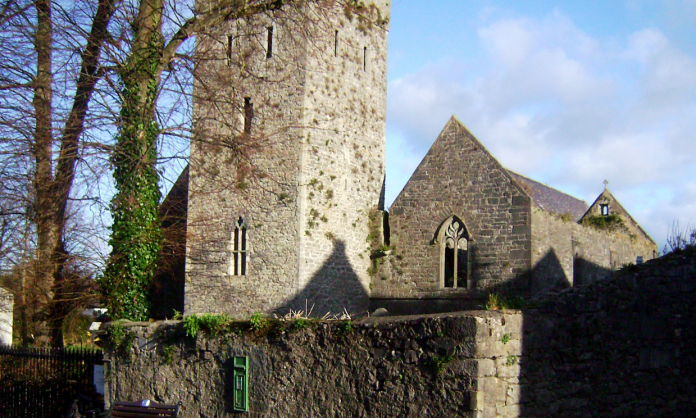By John Fitzgerald
Part of a County Kilkenny town’s heritage that was in decay and might have been lost forever has been beautifully restored.
St Mary’s Church, a 13th century Gothic style building in Green Street, Callan, is a major national monument in the town and among the most notable of its kind in Ireland. It dates to about the 1250s, when construction of the church began on the instructions of the Bishop of Ossory. It has been a magnet for tourists in recent years due to its renowned architectural and ornamental features and its captivating history.
Unfortunately the wrought iron gates fronting the building on Green Street had been in a poor state of repair for decades and locals feared they would fall away or disintegrate if the neglect continued. Callan people called for action to preserve the railings and also to repair the plinth and the stone walls surrounding the old church.
Now, relieved townspeople can behold with pride the result of a first rate restoration project just completed at the site.

Thanks to funding from the Heritage Council (under the Historic Towns Initiative) and from the County Council, the damage to the plinth has been repaired, using Kilkenny limestone and the iron railings are tastefully restored to their former glory. The exquisitely carved ornate points of the bars again shine bright, as they did in past centuries, and the gates are framed nicely by limestone piers. The whole project cost in the region of €150, 000.
The restoration work is expected to boost tourism in the town and spark a renewed interest in St Mary’s as a heritage gem. St Mary’s presents a magnificent sight to passers-by, standing as a memorial to a bygone era and a vastly different Ireland.
When you pass through the gates from Green Street, you find that large parts of the structure remain despite the passage of time and the ravages of history. The imposing central tower is the oldest part of the church, and there was once a wooden stairway leading up to the top, from where you had a panoramic view of Callan.
A roofless nave and side aisles survive in all their splendour, if a little weather-beaten and showing the natural effects of aging. The Chancel section is still roofed.

Most of what remains of the he building dates to the 15th century when the church was remodelled, and the West Tower replaced, a much needed innovation that added greatly to the buildings aesthetic and architectural appeal.
In 1530 a chapel was added and the chancel. The latter served Church of Ireland worshippers right up to the 1970s.
A walk around the interior reveals a host of cultural attractions. There are ornamental doorways that some visitors have described as heavenly. The one into the south aisle has lovely carvings of angels in flowing robes, and the one leading to the south aisle displays the likeness of a 15th century horned ladies headdress.
There are several tombstones dating to medieval times, including one marking the grave of Adam Le Blund, second husband of the Kilkenny notorious 14th century alleged witch, Alice Kyteler.
But in the midst of all these admirable features the visitor is reminded of a dark and terrible chapter in the history of St Mary’s.
In February 1650 Mass was being said in the church when the siege of Callan by Cromwell’s invading army commenced. As the priest addressed the congregation, cannon balls came crashing through the stained glass windows and from the ceiling over the heads of the worshippers.

The priest paused only to take note of what was happening before resuming his sermon. He seemed unruffled by the mayhem unfolding around him, even when timbers fell on either side of him and he narrowly avoided shards of flying glass as he stood behind the altar.
As the bombardment continued, he noticed a few people in the back row quietly getting up to leave the church. He called out to them to remain in their pews. Anyone who died in the middle of the Mass, he soothed, would go straight to Heaven.
So they remained until the end of the Mass, even when masonry crashed from the ceiling and cannonballs knocked over candles, starting small fires in the church. When Mass ended, they left the building, coughing and wheezing amid swirling clouds of dust and smoke.
A dozen or more had died, and scores nursed serious or minor injuries as they emerged from the place of worship.
But worse was to come. Three days after this episode, St Mary’s was again the focus of Cromwell’s war on Catholicism. Following the siege, during which the attackers had sustained heavy casualties at the hands of Callans brave defenders, Cromwell let his vengeful troops loose on the town.
Two hundred locals headed for St Mary’s and huddled within its sanctified walls, praying for their lives. Cromwell ignored their pleas for mercy, believing he had a sacred duty to destroy the last vestiges of Catholicism.

The solders stormed the church and killed every man, woman and child inside. A few who tried to escape by running up the wooden stairway to the tower were smoked out and either shot or put to the sword.
So, when you visit St Mary’s, you can connect with a turbulent but unforgettable past that will always be part of our heritage.
After you’ve passed through the newly restored wrought iron gateway and ascended the plinth, you’ll be stepping onto the hallowed ground where our ancestors paid the ultimate price for their faith.








